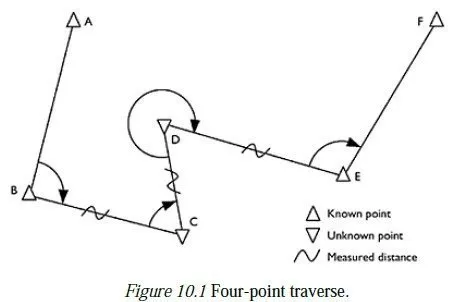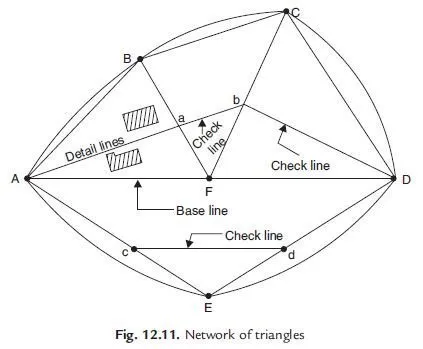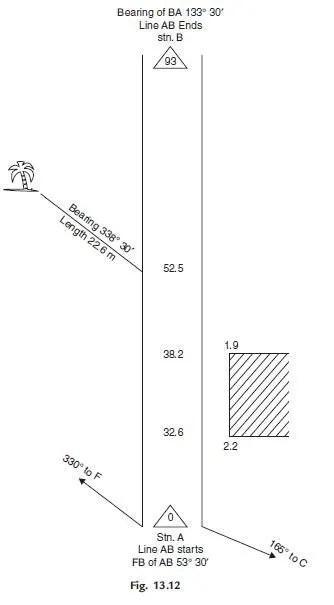Errors due to maladjustment of the instrument
In a properly adjusted theodolite:
1 the line of sight of the optical plummet should be along the vertical axis;
2 the trunnion axis should be perpendicular to the vertical axis;
3 the line of sight through the intersection of the reticle lines (called the line of
collimation) should be perpendicular to the trunnion axis;
4 the horizontal and the vertical reticle lines should be parallel to the trunnion and
vertical axes, respectively;
5 when the instrument is level and the line of collimation is horizontal, this should
correspond with the 90° or 270° mark on the vertical circle;
6 for convenience in setting up, the horizontal plate bubble should be central when the
vertical axis is vertical.
These points can be checked and permanent adjustments can be made to all of them. All
these adjustments are called permanent to distinguish them from the station
adjustments, which are made every time the instrument is set up.
In addition to the requirements listed above there are others which cannot be adjusted.
For example:
7 the horizontal circle should be perpendicular to the vertical axis, and the vertical circle
perpendicular to the trunnion axis;
8 the centre of the horizontal circle should coincide with the vertical axis, and the centre
of the vertical circle with the trunnion axis;
9 the circles should be accurately graduated;
10 there should be no backlash.
Tests to check the correct setting of a theodolite may be made and are described in
Section 4.5. If the instrument under test proves to be out of adjustment, refer to the
makers handbook for details. It is unwise to attempt any permanent adjustment to a
theodolite without prior training.
Although maladjusted theodolites can be tiresome to use, most of their effects on
observations are eliminated by the observation techniques which are described in the next
section.
4.4 Observations with a theodolite
Principles
It is neither necessary nor possible to ensure that the permanent adjustments described above are always faultless. The effects of these and other instrumental imperfections can be almost eliminated, and careless mistakes can be avoided, by suitable methods of observation.
In measuring horizontal angles, errors due to maladjustment of the trunnion axis are reversed in sign on changing face.6 Such errors are therefore eliminated by taking the mean of circle left (CL) and circle right (CR) measurements. All collimation errors are also reversed on changing face and are therefore eliminated in the same way. This applies to both horizontal and vertical angles. Since horizontal angles are obtained from the difference of two readings of the instrument, the effect of any error in horizontal collimation is in any case eliminated by subtraction, unless the points observed are at different altitudes. Vertical angles on the other hand are measured from a zero in the instrument itself (the alidade bubble), and measurements taken on one face only are therefore burdened with the whole vertical collimation error. It is therefore essential to take CL and CR observations for all vertical angles, and for all horizontal angles where high accuracy is required. Errors due to eccentric mounting and inaccurate graduation of the circles are reduced by repeating the observations using a different part of the circle;7 but equal numbers of CL and CR observations must be taken. It is common practice to swing the instrument to the right (SR) to observe successive stations when the instrument is circle left (or position I), and to swing it to the left (SL) when it is circle right (or position II). Errors due to any backlash in the instrument are reduced by using the mean of SR and SL measurements, by turning the tangent (slow motion) screws clockwise for their final adjustment and by always making the final optical micrometer adjustments in one direction. Besides eliminating certain instrument errors, taking the average of a number of measurements is desirable in itself; any gross errors in circle reading will be detected and can be discarded. Also, the ESD (from random causes) of the mean of n measurements varies inversely as . All the above precautions are included in the system of observing and booking suggested below.
Practical points
See that there is no play in the hinges between the legs and the tripod. If the tripod has sliding legs, see that the clamps are tight. Focus the telescope and micrometer eyepieces before levelling. Start with the tangent screws near the middle of their runs. Once the instrument is levelled, do not jar the tripod or even rest your hands on it. Avoid stepping near the tripods feet if the ground is soft. Swing the instrument by holding the vertical frames which support the telescope, not the telescope itself. Use the minimum of force on clamping screws. No routine of observation eliminates errors caused by inaccurate levelling of the instrument or inaccurate centring over the station mark.
Recording observations
Most instruments which display readings electronically are also capable of recording them onto a memory card. This subsection only applies to instruments where the readings must be recorded manually. Haphazard observation and random booking on loose paper lead to mistakes. For speed and accuracy, a system is essential. The one given here is the result of more than a century of experience in combating human and instrumental error. For efficient working, a separate observer and booker are necessary. Record all necessary data in an observation book. Use a fresh page for each station occupied. Book with a ball-point pen or pencil and make your figures neat and clear. Do not erase: make corrections by drawing a single line through the incorrect figures, leaving them legible and writing the correct figures beside or above them. A fair copy may be made later on another page if necessary (check carefully for copying errors), but the original pages must not be discarded. Notice that single-figure entries are written 06° 08² 05³, not 6° 8² 5³. The booker fills in the heading and the stations to be observed, while the observer is setting up the instrument. The observer calls out the readings; the booker records them and then reads back what (s)he has written;8 the observer then re-checks the reading and replies correct (or not). Do not omit this seemingly pedantic precaution it ensures that there is a closed loop between what is visible in the instrument and what is written in the book. It is the bookers duty to detect inconsistencies (such as excessive discrepancy between CR and CL readings) if one occurs, the observer is at once told to check, but is not told what is wrong. The booker works out reduced angles while the observer is observing the next target. Mental arithmetic is both quicker and less error-prone than use of a calculator in the field. The booker is responsible for ensuring that the stations are observed in the right order. Both surveyors should do their own jobs and not interfere with the other. Ideally, the observer checks the bookers arithmetic, and both sign the sheet before leaving the station. Remember that in practice the time taken in going to and from a station is large compared with the time actually spent there. So take every reasonable precaution to ensure that carelessness does not make a second visit necessary.



